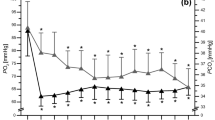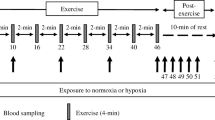Abstract
Objectives: A hyperbaric environment may influence lactate metabolism due to hyperoxia affecting biochemical pathways. The purpose of our study was to determine the blood lactate levels occurring at high workloads in a sample of professional divers under simulated caisson conditions. The ambient air pressure was equivalent to a diving depth of 30 m of seawater (400 kPa). Methods: A total of 23 healthy male subjects performed graded bicycle exercise in a dry hyperbaric chamber up to a maximum of 3.5 W kg−1 body weight at normal (100 kPa) and elevated ambient air pressure (400 kPa). The blood lactate level and the heart rate were measured. Results: In comparison with control conditions, the heart rate and the peripheral blood lactate level were significantly lower at depth for all workloads. Conclusions: The differences between the normobaric and hyperbaric lactate values may be explained by an overall improvement in lactate metabolism at elevated ambient pressure, especially in the working muscles and the organs responsible for the lactate reduction, i.e., the liver. The reduced heart rate may be an effect of the improved tissue oxygen supply at depth.
Similar content being viewed by others
Author information
Authors and Affiliations
Additional information
Received: 20 October 1998 / Accepted: 23 January 1999
Rights and permissions
About this article
Cite this article
Neubauer, B., Tetzlaff, K., Buslaps, C. et al. Blood lactate changes in men during graded workloads at normal atmospheric pressure (100 kPa) and under simulated caisson conditions (400 kPa). Int Arch Occup Environ Health 72, 178–181 (1999). https://doi.org/10.1007/s004200050358
Issue Date:
DOI: https://doi.org/10.1007/s004200050358




